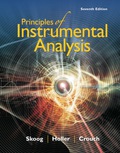
Principles of Instrumental Analysis
7th Edition
ISBN: 9781337468039
Author: Skoog
Publisher: Cengage
expand_more
expand_more
format_list_bulleted
Concept explainers
Textbook Question
Chapter 7, Problem 7.6QAP
Describe the differences and similarities between spontaneous and stimulated emission.
Expert Solution & Answer
Trending nowThis is a popular solution!

Students have asked these similar questions
Choose a number and match the atomic number to your element on the periodic table. For your element, write each of these features on a side of your figure.
1. Element Name and symbol
2. Family and group
3. What is it used for?
4. Sketch the Valence electron orbital
5. What ions formed. What is it's block on the periodic table.
6. Common compounds
7. Atomic number
8. Mass number
9. Number of neutrons- (show calculations)
10. Sketch the spectral display of the element
11.Properties
12. Electron configuration
13. Submit a video of a 3-meter toss in slow-mo
[In this question, there are multiple answers to type in a "fill-in-the-blank" fashion - in each case, type in a whole number.] Consider using Slater's Rules to calculate the shielding factor (S) for the last electron in silicon (Si). There will be
electrons with a 0.35 S-multiplier,
electrons with a 0.85 S-multiplier, and
electrons with a 1.00 S-multiplier.
Provide the unknown for the given data.
Chapter 7 Solutions
Principles of Instrumental Analysis
Ch. 7 - Prob. 7.1QAPCh. 7 - Prob. 7.2QAPCh. 7 - The Wien displacement law states that the...Ch. 7 - Prob. 7.4QAPCh. 7 - Prob. 7.5QAPCh. 7 - Describe the differences and similarities between...Ch. 7 - Prob. 7.7QAPCh. 7 - Prob. 7.8QAPCh. 7 - Prob. 7.9QAPCh. 7 - Prob. 7.10QAP
Ch. 7 - Why is glass better than fused silica as a prism...Ch. 7 - Prob. 7.12QAPCh. 7 - Prob. 7.13QAPCh. 7 - Prob. 7.14QAPCh. 7 - Prob. 7.15QAPCh. 7 - Prob. 7.16QAPCh. 7 - Prob. 7.17QAPCh. 7 - Prob. 7.18QAPCh. 7 - Prob. 7.19QAPCh. 7 - Prob. 7.20QAPCh. 7 - Prob. 7.21QAPCh. 7 - Prob. 7.22QAPCh. 7 - Prob. 7.23QAPCh. 7 - Prob. 7.24QAP
Knowledge Booster
Learn more about
Need a deep-dive on the concept behind this application? Look no further. Learn more about this topic, chemistry and related others by exploring similar questions and additional content below.Similar questions
- Draw the Lewis structures of two methanol (CH3OH) molecules and depict hydrogenbonding between them with dashed lines. Show all lone pairs. Provide a thorough analysis to apply concept idea into other problems.arrow_forwardSteps and explanation please.arrow_forwardHow could you distinguish between each pair of compounds below using IR? For each pair citeone bond and it’s frequency that you could use to distinguish between them. Please provide thorough analysis to apply into further problems.arrow_forward
- Electron Arrangement A. Fill in the following chart relating to levels, sublevels and orbitals. Levels (n) 1 Sublevels # of Orbitals per sublevel 2 3 4 # of Electrons per sublevel Total Electrons per level Complete: B. Answer the following questions related to levels, sublevels, orbitals and electrons. 1. How many sublevels are in energy level 2? 2. How many orbitals are in a 4f sublevel? 3. How many electrons can level 3 hold? 4. How many orbitals are in level 4? 5. How many electrons can sublevel 2p hold? 11arrow_forwardProvide the unknown for the given details.arrow_forwardPart II. For the following compounds predict the no. Of signals expected for the 9) c) b d) C-NMR spectrum: لكمarrow_forward
arrow_back_ios
SEE MORE QUESTIONS
arrow_forward_ios
Recommended textbooks for you
 Principles of Instrumental AnalysisChemistryISBN:9781305577213Author:Douglas A. Skoog, F. James Holler, Stanley R. CrouchPublisher:Cengage Learning
Principles of Instrumental AnalysisChemistryISBN:9781305577213Author:Douglas A. Skoog, F. James Holler, Stanley R. CrouchPublisher:Cengage Learning Principles of Modern ChemistryChemistryISBN:9781305079113Author:David W. Oxtoby, H. Pat Gillis, Laurie J. ButlerPublisher:Cengage Learning
Principles of Modern ChemistryChemistryISBN:9781305079113Author:David W. Oxtoby, H. Pat Gillis, Laurie J. ButlerPublisher:Cengage Learning
 Physical ChemistryChemistryISBN:9781133958437Author:Ball, David W. (david Warren), BAER, TomasPublisher:Wadsworth Cengage Learning,Chemistry: Matter and ChangeChemistryISBN:9780078746376Author:Dinah Zike, Laurel Dingrando, Nicholas Hainen, Cheryl WistromPublisher:Glencoe/McGraw-Hill School Pub Co
Physical ChemistryChemistryISBN:9781133958437Author:Ball, David W. (david Warren), BAER, TomasPublisher:Wadsworth Cengage Learning,Chemistry: Matter and ChangeChemistryISBN:9780078746376Author:Dinah Zike, Laurel Dingrando, Nicholas Hainen, Cheryl WistromPublisher:Glencoe/McGraw-Hill School Pub Co

Principles of Instrumental Analysis
Chemistry
ISBN:9781305577213
Author:Douglas A. Skoog, F. James Holler, Stanley R. Crouch
Publisher:Cengage Learning

Principles of Modern Chemistry
Chemistry
ISBN:9781305079113
Author:David W. Oxtoby, H. Pat Gillis, Laurie J. Butler
Publisher:Cengage Learning



Physical Chemistry
Chemistry
ISBN:9781133958437
Author:Ball, David W. (david Warren), BAER, Tomas
Publisher:Wadsworth Cengage Learning,

Chemistry: Matter and Change
Chemistry
ISBN:9780078746376
Author:Dinah Zike, Laurel Dingrando, Nicholas Hainen, Cheryl Wistrom
Publisher:Glencoe/McGraw-Hill School Pub Co
Quantum Mechanics - Part 1: Crash Course Physics #43; Author: CrashCourse;https://www.youtube.com/watch?v=7kb1VT0J3DE;License: Standard YouTube License, CC-BY